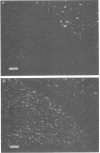Abstract
1. Changes in isometric tension were recorded from circular muscle strips of rat pyloric sphincter in vitro, in response to electrical field stimulation and exogenously applied muscle relaxants. 2. Concentration-response relationships were studied for relaxation to exogenously applied adenosine 5'-triphosphate (ATP) and two analogues, 2-methylthioATP (2-MeSATP) and alpha,beta-methylene ATP (alpha,beta-MeATP). These drugs evoked concentration-dependent relaxation of rat pyloric sphincter with an order of potency 2-MeSATP > ATP >> alpha,beta-MeATP, indicating the presence of P2y-purinoceptors. The IC50 value of each nucleotide was: 2-MeSATP, 5.0 x 10(-8); ATP, 7.9 x 10(-6) M; alpha,beta-MeATP showed only slight activity at a concentration of 0.1 mM. 3. Frequency-response relationships for relaxations evoked by electrical field stimulation (EFS) were studied in the absence and presence of 10 microM NG-nitro-L-arginine methyl ester (L-NAME, an inhibitor of nitric oxide (NO) synthesis) and 20 microM reactive blue 2 (a P2y-purinoceptor antagonist). It was found that these substances significantly reduced the relaxant response of rat pyloric sphincter to EFS by 40% and 50% respectively. In the presence of both L-NAME and reactive blue 2 the responses were reduced by 75%. 4. Concentration-response relationships were studied for ATP and 2-MeSATP in the presence of L-NAME. It was found that L-NAME did not significantly inhibit the relaxant responses to these drugs. 5. Concentration-response relationships for ATP and noradrenaline were studied in the presence of reactive blue 2 (20 microM); the P2y-antagonist significantly inhibited the relaxant response to ATP, but not that to noradrenaline.(ABSTRACT TRUNCATED AT 250 WORDS)
Full text
PDF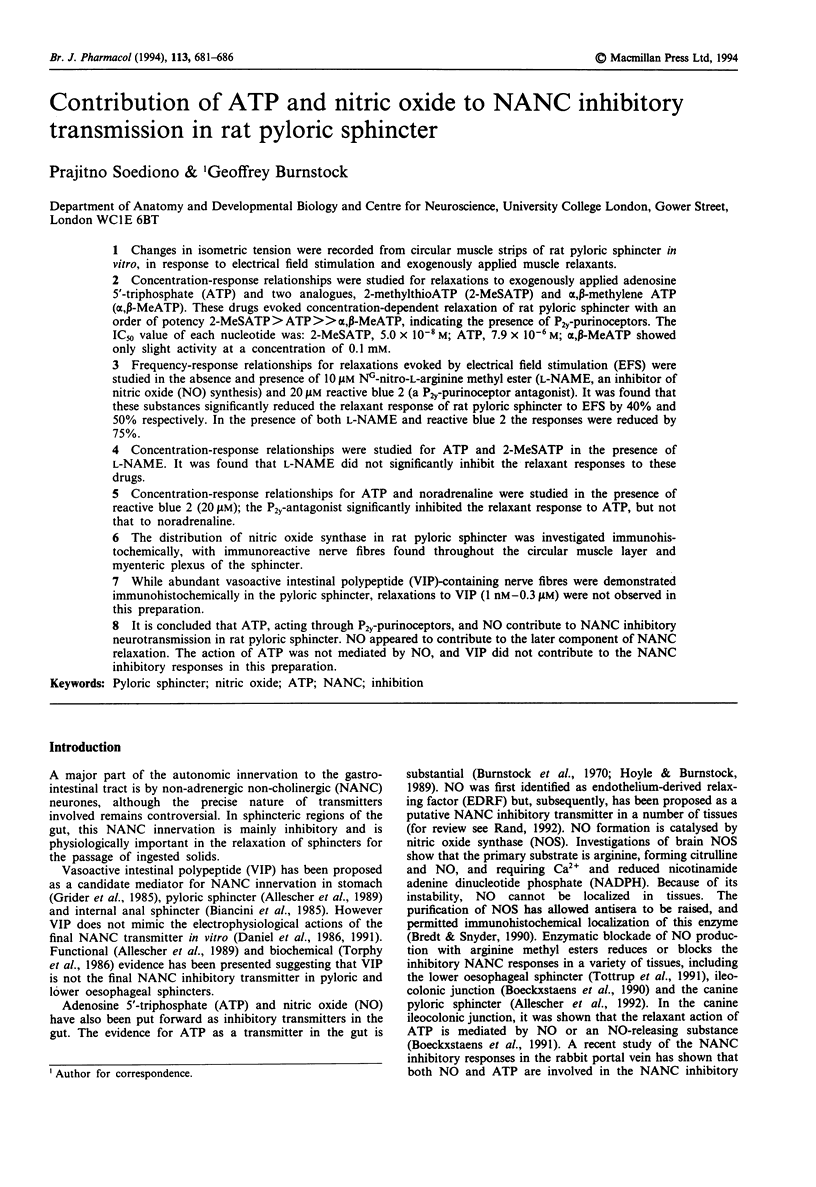
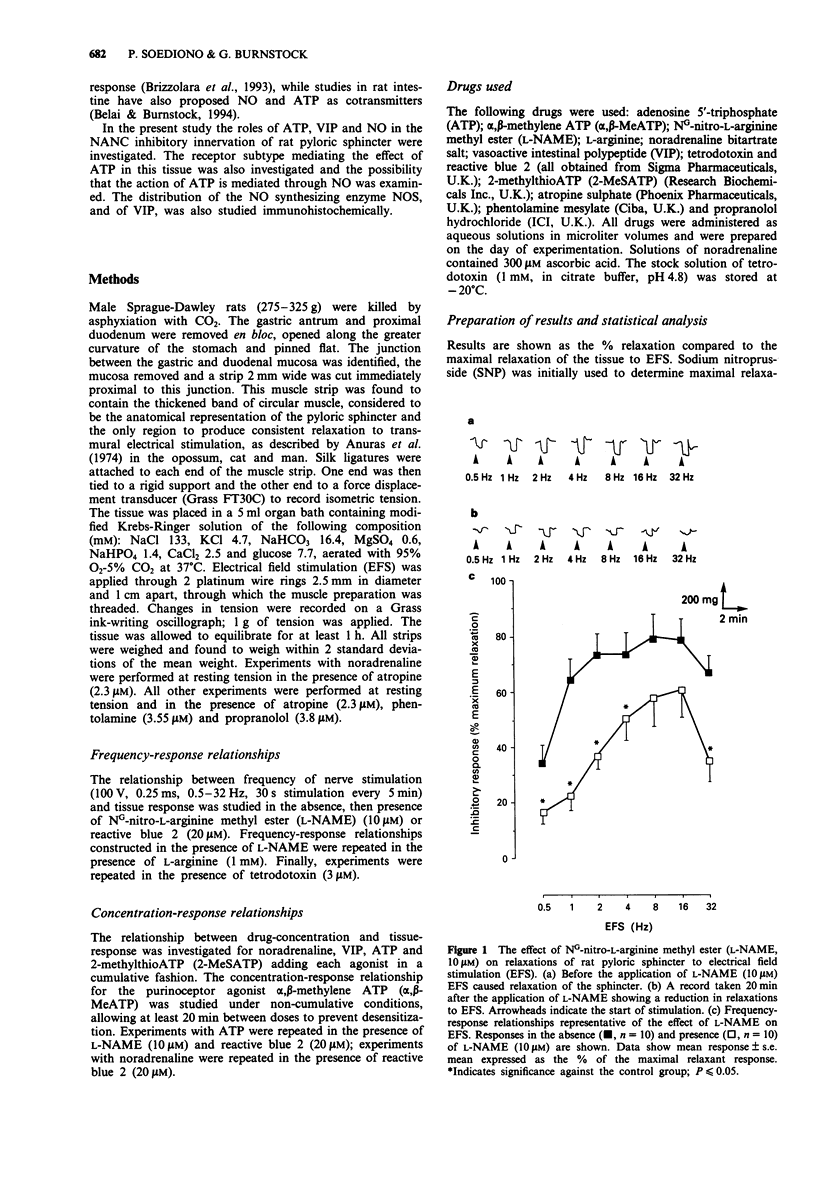
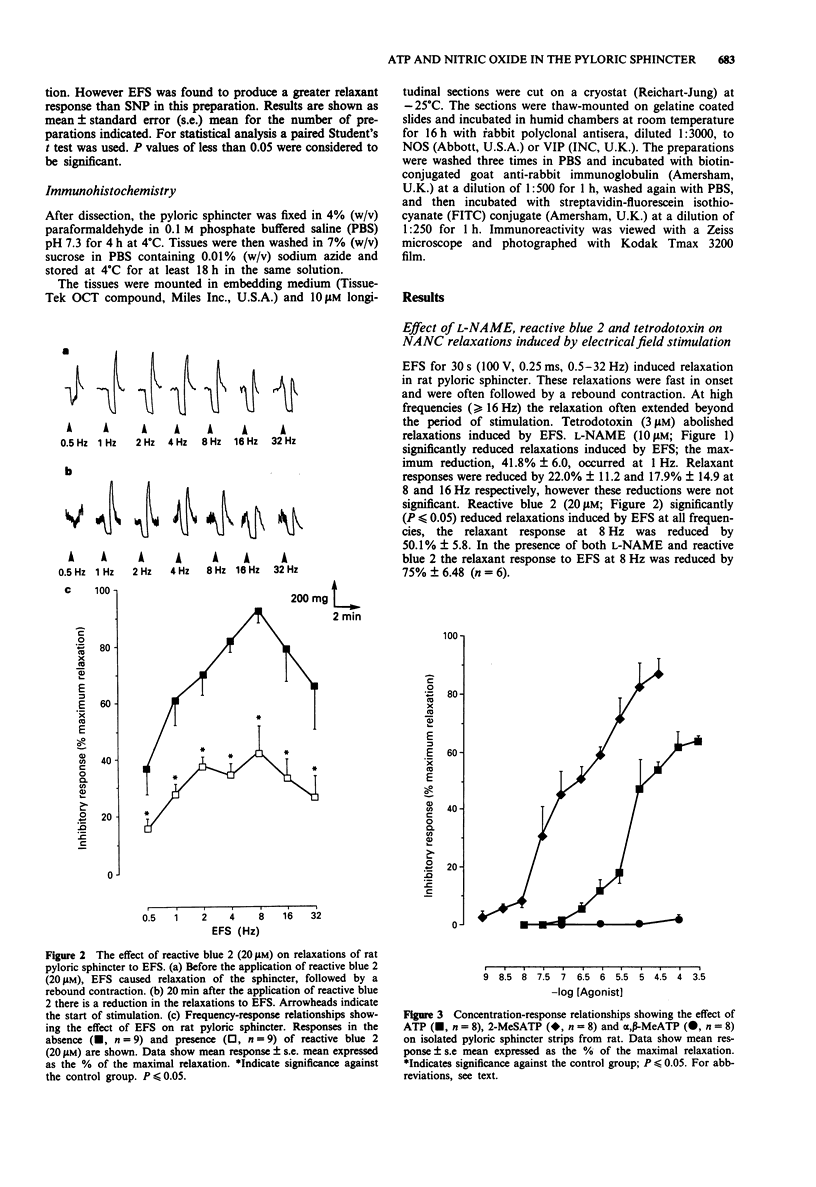
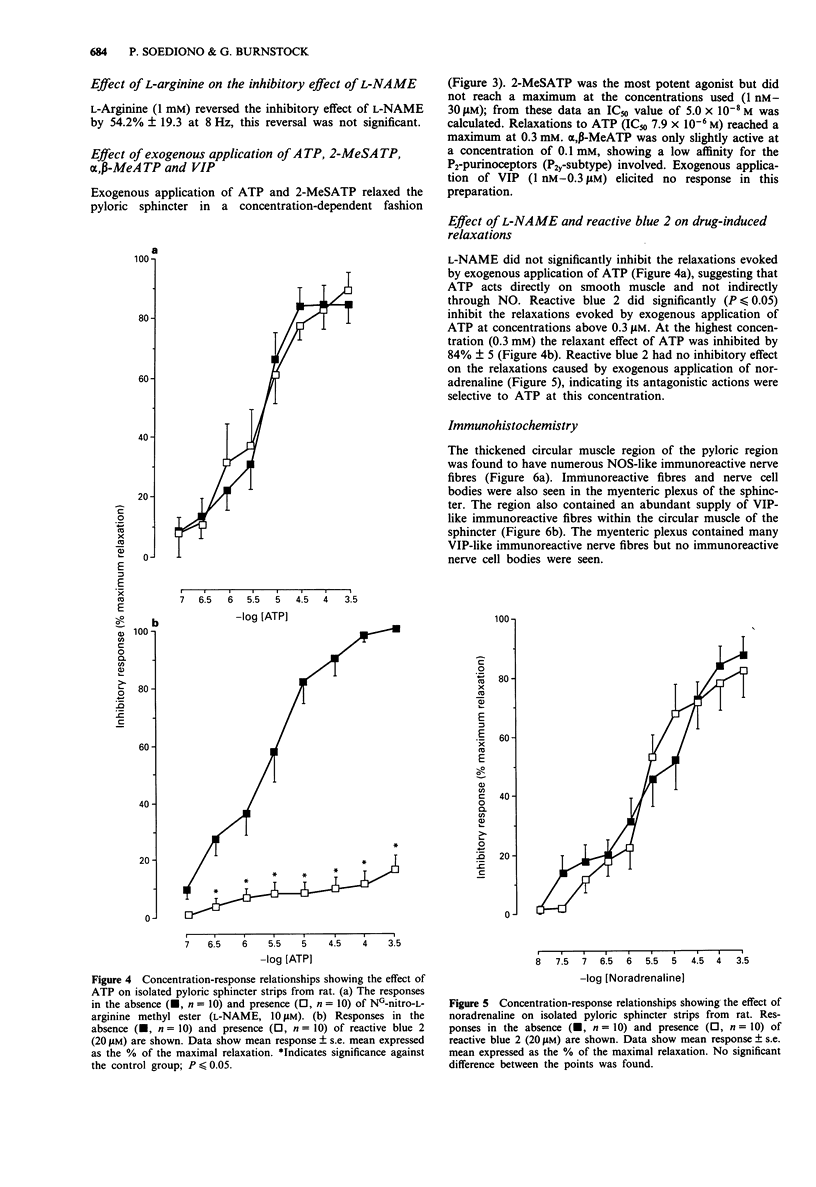
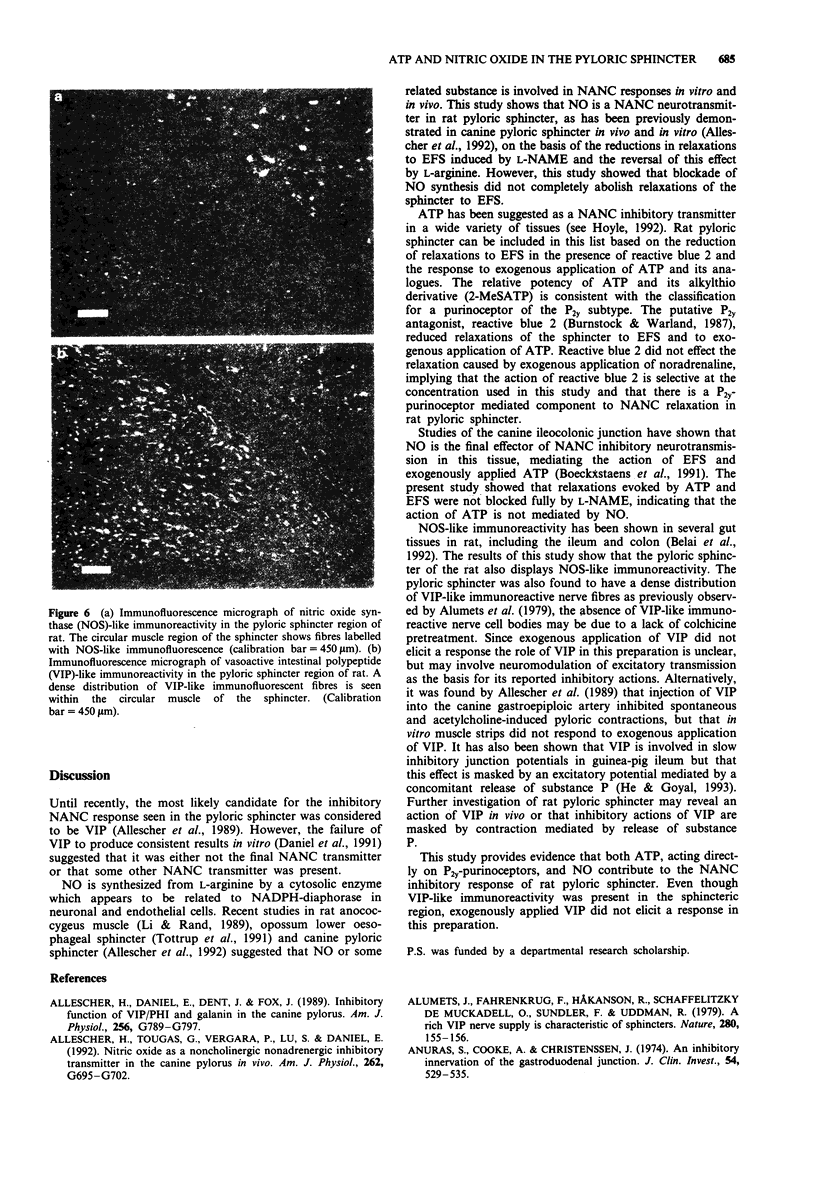
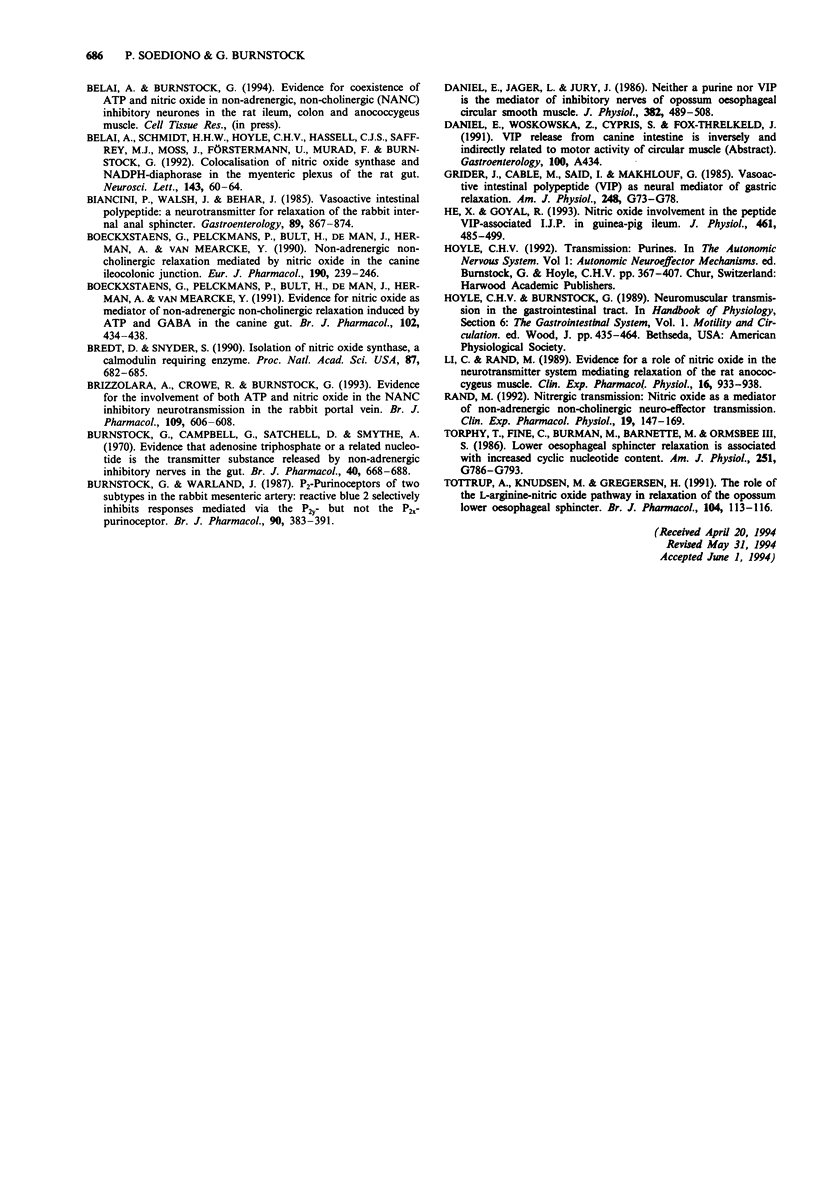
Images in this article
Selected References
These references are in PubMed. This may not be the complete list of references from this article.
- Allescher H. D., Daniel E. E., Dent J., Fox J. E. Inhibitory function of VIP-PHI and galanin in canine pylorus. Am J Physiol. 1989 Apr;256(4 Pt 1):G789–G797. doi: 10.1152/ajpgi.1989.256.4.G789. [DOI] [PubMed] [Google Scholar]
- Allescher H. D., Tougas G., Vergara P., Lu S., Daniel E. E. Nitric oxide as a putative nonadrenergic noncholinergic inhibitory transmitter in the canine pylorus in vivo. Am J Physiol. 1992 Apr;262(4 Pt 1):G695–G702. doi: 10.1152/ajpgi.1992.262.4.G695. [DOI] [PubMed] [Google Scholar]
- Alumets J., Schaffalitzky de Muckadell O., Fahrenkrug J., Sundler F., Håkanson R., Uddman R. A rich VIP nerve supply is characteristic of sphincters. Nature. 1979 Jul 12;280(5718):155–156. doi: 10.1038/280155a0. [DOI] [PubMed] [Google Scholar]
- Anuras S., Cooke A. R., Christensen J. An inhibitory innervation at the gastroduodenal junction. J Clin Invest. 1974 Sep;54(3):529–535. doi: 10.1172/JCI107789. [DOI] [PMC free article] [PubMed] [Google Scholar]
- Belai A., Schmidt H. H., Hoyle C. H., Hassall C. J., Saffrey M. J., Moss J., Förstermann U., Murad F., Burnstock G. Colocalization of nitric oxide synthase and NADPH-diaphorase in the myenteric plexus of the rat gut. Neurosci Lett. 1992 Aug 31;143(1-2):60–64. doi: 10.1016/0304-3940(92)90233-w. [DOI] [PubMed] [Google Scholar]
- Biancani P., Walsh J., Behar J. Vasoactive intestinal peptide: a neurotransmitter for relaxation of the rabbit internal anal sphincter. Gastroenterology. 1985 Oct;89(4):867–874. doi: 10.1016/0016-5085(85)90585-2. [DOI] [PubMed] [Google Scholar]
- Boeckxstaens G. E., Pelckmans P. A., Bult H., De Man J. G., Herman A. G., Van Maercke Y. M. Non-adrenergic non-cholinergic relaxation mediated by nitric oxide in the canine ileocolonic junction. Eur J Pharmacol. 1990 Nov 6;190(1-2):239–246. doi: 10.1016/0014-2999(90)94132-h. [DOI] [PubMed] [Google Scholar]
- Boeckxstaens G. E., Pelckmans P. A., Bult H., De Man J. G., Herman A. G., van Maercke Y. M. Evidence for nitric oxide as mediator of non-adrenergic non-cholinergic relaxations induced by ATP and GABA in the canine gut. Br J Pharmacol. 1991 Feb;102(2):434–438. doi: 10.1111/j.1476-5381.1991.tb12191.x. [DOI] [PMC free article] [PubMed] [Google Scholar]
- Bredt D. S., Snyder S. H. Isolation of nitric oxide synthetase, a calmodulin-requiring enzyme. Proc Natl Acad Sci U S A. 1990 Jan;87(2):682–685. doi: 10.1073/pnas.87.2.682. [DOI] [PMC free article] [PubMed] [Google Scholar]
- Brizzolara A. L., Crowe R., Burnstock G. Evidence for the involvement of both ATP and nitric oxide in non-adrenergic, non-cholinergic inhibitory neurotransmission in the rabbit portal vein. Br J Pharmacol. 1993 Jul;109(3):606–608. doi: 10.1111/j.1476-5381.1993.tb13614.x. [DOI] [PMC free article] [PubMed] [Google Scholar]
- Burnstock G., Campbell G., Satchell D., Smythe A. Evidence that adenosine triphosphate or a related nucleotide is the transmitter substance released by non-adrenergic inhibitory nerves in the gut. Br J Pharmacol. 1970 Dec;40(4):668–688. doi: 10.1111/j.1476-5381.1970.tb10646.x. [DOI] [PMC free article] [PubMed] [Google Scholar]
- Burnstock G., Warland J. J. P2-purinoceptors of two subtypes in the rabbit mesenteric artery: reactive blue 2 selectively inhibits responses mediated via the P2y-but not the P2x-purinoceptor. Br J Pharmacol. 1987 Feb;90(2):383–391. doi: 10.1111/j.1476-5381.1987.tb08968.x. [DOI] [PMC free article] [PubMed] [Google Scholar]
- Daniel E. E., Jager L. P., Jury J. Catecholamines release mediators in the opossum oesophageal circular smooth muscle. J Physiol. 1987 Jan;382:489–508. doi: 10.1113/jphysiol.1987.sp016380. [DOI] [PMC free article] [PubMed] [Google Scholar]
- Grider J. R., Cable M. B., Said S. I., Makhlouf G. M. Vasoactive intestinal peptide as a neural mediator of gastric relaxation. Am J Physiol. 1985 Jan;248(1 Pt 1):G73–G78. doi: 10.1152/ajpgi.1985.248.1.G73. [DOI] [PubMed] [Google Scholar]
- He X. D., Goyal R. K. Nitric oxide involvement in the peptide VIP-associated inhibitory junction potential in the guinea-pig ileum. J Physiol. 1993 Feb;461:485–499. doi: 10.1113/jphysiol.1993.sp019524. [DOI] [PMC free article] [PubMed] [Google Scholar]
- Li C. G., Rand M. J. Evidence for a role of nitric oxide in the neurotransmitter system mediating relaxation of the rat anococcygeus muscle. Clin Exp Pharmacol Physiol. 1989 Dec;16(12):933–938. doi: 10.1111/j.1440-1681.1989.tb02404.x. [DOI] [PubMed] [Google Scholar]
- Rand M. J. Nitrergic transmission: nitric oxide as a mediator of non-adrenergic, non-cholinergic neuro-effector transmission. Clin Exp Pharmacol Physiol. 1992 Mar;19(3):147–169. doi: 10.1111/j.1440-1681.1992.tb00433.x. [DOI] [PubMed] [Google Scholar]
- Torphy T. J., Fine C. F., Burman M., Barnette M. S., Ormsbee H. S., 3rd Lower esophageal sphincter relaxation is associated with increased cyclic nucleotide content. Am J Physiol. 1986 Dec;251(6 Pt 1):G786–G793. doi: 10.1152/ajpgi.1986.251.6.G786. [DOI] [PubMed] [Google Scholar]
- Tøttrup A., Knudsen M. A., Gregersen H. The role of the L-arginine-nitric oxide pathway in relaxation of the opossum lower oesophageal sphincter. Br J Pharmacol. 1991 Sep;104(1):113–116. doi: 10.1111/j.1476-5381.1991.tb12393.x. [DOI] [PMC free article] [PubMed] [Google Scholar]



